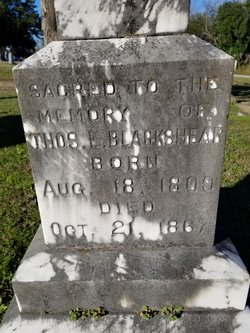During the 1850s, as Thomas County's population increased rapidly, Blackshear grew restless and decided to migrate westward. He sold his property and moved to Texas with a large retinue of slaves in 1858. He took up cotton planting on a tract of bottomland near the Navasota River just east of Navasota in southwestern Grimes County. He soon purchased additional land along the Brazos River south of Navasota. By 1860 he had amassed property valued at $150,000 and was thus one of the two wealthiest men in the county; his estate then included 123 slaves, a number that grew to 152 by 1865. A notable aspect of his plantation management was his utilization of blacks as "drivers" and in other positions of trust. Although Blackshear himself did not serve in the military during the Civil War, four of his sons fought in the armies of the Confederacy.
Like many other planters Blackshear experienced great difficulties adjusting to the harsh realities of agriculture in Reconstruction Texas. Dismayed at what he considered the unreliable work habits of freedmen, he resolved to cultivate his property exclusively with white sharecroppers, each farming tracts of from forty to sixty acres. In an effort to recruit the necessary labor, he corresponded with newspaper editors in his native state, including Lucius C. Bryan of the Thomasville Southern Enterprise, to enlist their cooperation in advertising the advantages of Texas agriculture to poor white farmers struggling for subsistence on the exhausted soils of Georgia. Blackshear was planning a trip to Georgia to engage tenants when he contracted yellow fever and died on October 20, 1867.
Marie Giles, "BLACKSHEAR, THOMAS EDWARD," Handbook of Texas Online
During the 1850s, as Thomas County's population increased rapidly, Blackshear grew restless and decided to migrate westward. He sold his property and moved to Texas with a large retinue of slaves in 1858. He took up cotton planting on a tract of bottomland near the Navasota River just east of Navasota in southwestern Grimes County. He soon purchased additional land along the Brazos River south of Navasota. By 1860 he had amassed property valued at $150,000 and was thus one of the two wealthiest men in the county; his estate then included 123 slaves, a number that grew to 152 by 1865. A notable aspect of his plantation management was his utilization of blacks as "drivers" and in other positions of trust. Although Blackshear himself did not serve in the military during the Civil War, four of his sons fought in the armies of the Confederacy.
Like many other planters Blackshear experienced great difficulties adjusting to the harsh realities of agriculture in Reconstruction Texas. Dismayed at what he considered the unreliable work habits of freedmen, he resolved to cultivate his property exclusively with white sharecroppers, each farming tracts of from forty to sixty acres. In an effort to recruit the necessary labor, he corresponded with newspaper editors in his native state, including Lucius C. Bryan of the Thomasville Southern Enterprise, to enlist their cooperation in advertising the advantages of Texas agriculture to poor white farmers struggling for subsistence on the exhausted soils of Georgia. Blackshear was planning a trip to Georgia to engage tenants when he contracted yellow fever and died on October 20, 1867.
Marie Giles, "BLACKSHEAR, THOMAS EDWARD," Handbook of Texas Online
Family Members
Advertisement
Records on Ancestry
Advertisement











